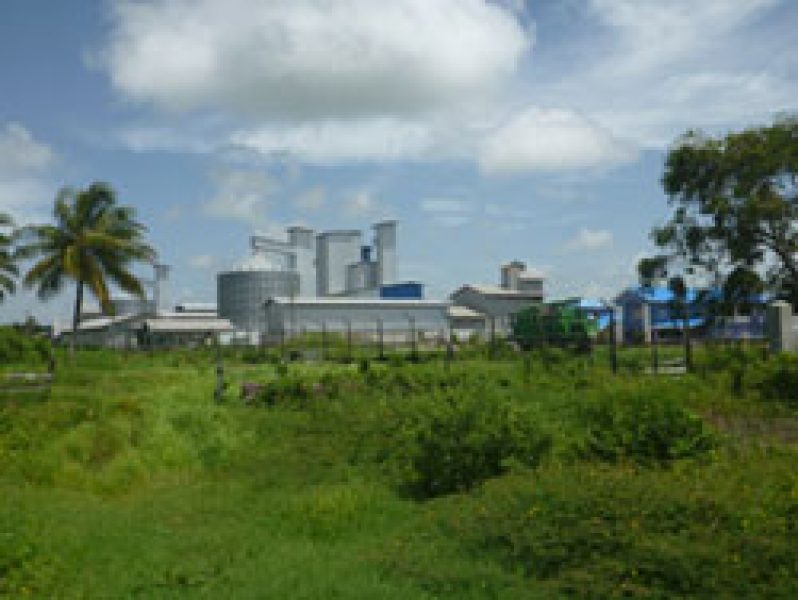OUR destination this week is the very quaint but quiet community of De Hoop, located in the Demerara/Mahaica region; and one certainly has to agree that this village does not only possess a certain mystic allure, but also stands out as one of those few locations whose inhabitants possess a rare contentment, even though they may be plagued by issues aplenty, many of which might cause them some measure of discomfort from time to time.
 A once thriving estate with rich agricultural potential, De Hoop is located 1 metre above sea level, and approximately 42km from the city of Georgetown. Its coordinates are 6°39’0″ N and 57°54’0″ E in DMS (Degrees Minutes Seconds) or 6.65 and -57.9 (in decimal degrees). Its UTM position is VH03, and its Joint Operation Graphics reference is NB21-06.
A once thriving estate with rich agricultural potential, De Hoop is located 1 metre above sea level, and approximately 42km from the city of Georgetown. Its coordinates are 6°39’0″ N and 57°54’0″ E in DMS (Degrees Minutes Seconds) or 6.65 and -57.9 (in decimal degrees). Its UTM position is VH03, and its Joint Operation Graphics reference is NB21-06.
If you are an early riser and happen to be in this pleasant community, you won’t want to miss the sun rise, in all its resplendent glory, at around 06:10hrs; evenings are equally as fascinating, as the sun makes its inexorable way west across the skies in a kaleidoscope of colour, before disappearing behind the sometimes billowing clouds. As we said earlier, De Hoop is a large commercialized agricultural landholding with associated features that makes it appealing to the eyes.
As we said earlier, De Hoop is a large commercialized agricultural landholding with associated features that makes it appealing to the eyes.
What we realised in the little time we spent there, was that villagers and even residents of neighbouring communities were actually referring to a series of smaller settlements as the entire De Hoop area; these communities include Belvedere, the Branch Road, Strong Groom, Region Back, Broken Water Land, and a few others.
Our arrival
As our bus rolled noisily into the Mahaica Market Square to disgorge its passengers, we were faced with the daunting task of either joining the mad rush of dishevelled commuters trying to board other minibuses or hire cars to take them to such destinations as De Hoop, and even as far off as Calcutta, in neighbouring Mahaicony.
The pushing and tugging becoming too much for us, we opted instead to take a taxi to where we were going.
Our taxi driver turned out to be very jovial; and very informative, too. It was he who told us that it was customary in the past to refer to several places in the area as De Hoop.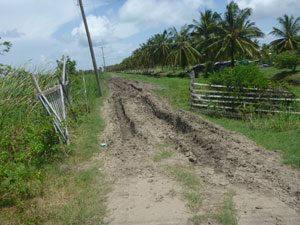 That said, he took us first to the very impressive Rayaadul Hakh Rice Milling Complex. There we met a very polite administrative official who was obviously reluctant to divulge any information about the company the moment he laid eyes on our media identification badges.
That said, he took us first to the very impressive Rayaadul Hakh Rice Milling Complex. There we met a very polite administrative official who was obviously reluctant to divulge any information about the company the moment he laid eyes on our media identification badges.
Not wanting to leave empty-handed, however, we cajoled him at length, until he finally gave in and divulged that the complex employs over fifty workers and services rice farmers from Mahaica, Mahaicony, and Berbice. But he staunchly refused to let us have photos of their operations, so we had to content ourselves with taking them outside of the complex.
Turns out that several smaller rice mills exist in the backland regions of De Hoop, but the Rayaadul Hakh Rice Milling Complex is by far the most attractive and sophisticated mill in De Hoop.
Despite the scorching midday sun, we had to admit that exploring the De Hoop community was a fun experience. We considered the tractors, hymacs and combine harvesters we saw in many yards tangible evidence of the rich agricultural potential of this community.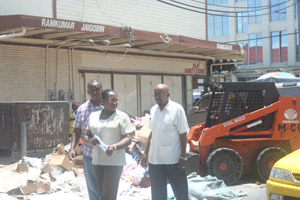 The only disappointment was that despite the cheerful and jovial demeanour of the residents, they became reticent, and in many cases refused to comment on things that were bothering them, because they realised we represented a media operation. This attitude, however, was not evident among those from the backland areas of De Hoop.
The only disappointment was that despite the cheerful and jovial demeanour of the residents, they became reticent, and in many cases refused to comment on things that were bothering them, because they realised we represented a media operation. This attitude, however, was not evident among those from the backland areas of De Hoop.
We were enthralled by the pleasant sight of cattle, sheep and goats grazing peacefully in sprawling pastures that offered lush, green grass and shrubs. As we walked along what is called the Branch Road, it was quite intriguing to see patwa, hourri, and other ‘bush fish’ flipping over in their numbers in the roadside trenches.
Pond flies zoomed noisily around our heads, and colourful butterflies swarming in from the nearby pastures seemed to investigate our presence, before fluttering off to the trees as if assured that we represented entirely no threat to their wild and carefree existence. It was kind of strange that there hardly seemed to be anyone in the streets, save for a few persons rushing home with their supplies of groceries from RAM’S Variety Store, or from the lone meat centre in the community. Those who purchased much larger quantities of home supplies would do so at the Mahaica Market, and transport it in hire cars to their homes.
It was kind of strange that there hardly seemed to be anyone in the streets, save for a few persons rushing home with their supplies of groceries from RAM’S Variety Store, or from the lone meat centre in the community. Those who purchased much larger quantities of home supplies would do so at the Mahaica Market, and transport it in hire cars to their homes.
Enquires revealed that since most of the villagers were employed as farmers, they were in the fields all day, and the wives and children were contented to remain at home and enjoy their ‘midday siesta’.
De Hoop of old
Mahase Rampertab, a 72-year-old a retired fisherman, told us about De Hoop Village before its present evolution. Claiming he has lived in the area for most of his existence, Rampertab said that in the olden days De Hoop was sprawling pastures with the most luscious of grass and plant vegetation. Yes, there were houses there, but those were built far from each other, since the community was very underdeveloped. Drainage and irrigation were major problems for persons living in areas which are now called Branch Road, Strong Groom, Region Back, and Broken Water Land.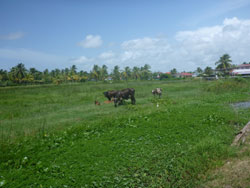 During those days, residents battled with muddy roads, and farmers battled fiercely to save their rice and cash crops during the rainy seasons. Many areas were swampy and constituted a haven for snakes and other reptiles.
During those days, residents battled with muddy roads, and farmers battled fiercely to save their rice and cash crops during the rainy seasons. Many areas were swampy and constituted a haven for snakes and other reptiles.
Development boom
With the passage of time, more and more people settled on the land, and De Hoop began to develop as people pounced on its agricultural possibilities.
More houses were constructed, and then came schools, not to mention a few grocery outlets. Rice farmers extended their fields, and even the cash crop farmers enlarged their plots as well. Today, De Hoop is a commercialised cluster of villages, all booming with great economic and agricultural activities. And it’s truly amazing how contented these people are, although there are still things in the village that need to be fixed. Today, all seems to be well in De Hoop Village as residents hustle around always in pursuit of some tangible objective.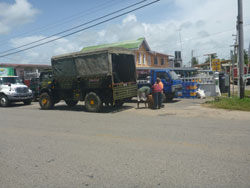 Big and established stores were not seen in the area, but villagers make do with the reasonably large ‘Ram’s Variety Store’, situated at the Main Road Junction, and another impressive unnamed store that offers the same goods and services.
Big and established stores were not seen in the area, but villagers make do with the reasonably large ‘Ram’s Variety Store’, situated at the Main Road Junction, and another impressive unnamed store that offers the same goods and services.
Quite close to these two establishments is another shop that sells beverages and sweets, and it is also fitted with a ‘rum shop extension’ where the guys can take a little something in the evenings or at weekends.
A saddening mishap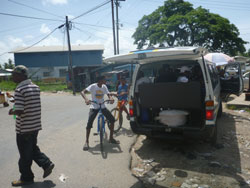 Residents were elated to report that the community is almost without any criminal elements, but a few persons told the harrowing tale of a resident (farmer) who had been brutally murdered by bandits in 2010 as he was making his way back to the village.
Residents were elated to report that the community is almost without any criminal elements, but a few persons told the harrowing tale of a resident (farmer) who had been brutally murdered by bandits in 2010 as he was making his way back to the village.
And I marvelled at the intensity with which housewife Parbattie Ramnarine told this tale. She was so emotional that she actually transposed me to that unfortunate night when the incident occurred. Though she could not remember the actually date, she said she was certain that it was in August 2010 when 35-year-old rice farmer Lakeram Bishun Dial, called Mohan, was murdered.
According to Parbattie, an intended wedding celebration took a devastating turn for a Mahaica, East Coast Demerara family when Dial was shot dead by bandits in a truck at Hope, East Coast Demerara, after he had decided to stop and talk with his younger brother, Totaram, who was heading home after a trip to a commercial bank in the city.
Totaram, due to get married the said weekend, had gone to Georgetown to withdraw cash from a commercial bank. He was returning home in a blue Hilux Surf four-runner, and had stopped to talk to Dial when two men on a motorcycle arrived.
Parbattie said Totaram jumped into a trench, and then two shots were fired; whereupon it was discovered that his elder brother Mohan was shot. Totaram rushed Mohan to a private hospital, but he was pronounced dead on arrival. After attacking the Dials, the bandits fled with a bag of cash that Totaram had had in the vehicle. They headed in the direction of Georgetown, some residents said.
After attacking the Dials, the bandits fled with a bag of cash that Totaram had had in the vehicle. They headed in the direction of Georgetown, some residents said.
Quick police action resulted in the motorcycle allegedly used in the robbery being recovered at Victoria, East Coast Demerara; and further investigations led to its driver being apprehended in an abandoned house in Victoria. Two other suspects were also arrested, and were assisting police with their investigations.
Residents noted that things are much quieter at De Hoop, save for a few cases in which outsiders stole poultry and, in some cases, cattle reared in the backland regions.
A few challenges Residents at Strong Groom, Branch Road and Region Back say life is good, despite their being forced to face flooding in many areas. They would greatly appreciate if the authorities would properly pave and maintain the access roads, and build dams that would not buckle under the rigorous traffic of agricultural machinery during the rainy seasons.
Residents at Strong Groom, Branch Road and Region Back say life is good, despite their being forced to face flooding in many areas. They would greatly appreciate if the authorities would properly pave and maintain the access roads, and build dams that would not buckle under the rigorous traffic of agricultural machinery during the rainy seasons.
There are no nightclubs or discos in De Hoop, and some housewives smilingly related that they have grown accustomed to house parties, or they await the news of weddings or birthdays to see the village explode with great festivity and revelry.
One grandmother, Baswanttie Parsaram, reminisced on her childhood days when weddings and such events were the ‘in thing’, before modernisation brought with it new concept parties and the like.
“In me young days we nah bin get any disco and dem thing dah! And we nah get it today, and we nah miss nothing! Man, look…when me bin ah wan lil gal, ah suh we ah get excited when somebody ah married. Because in dem days, ah wedding de mean days and days ah partying! If yuh see how dem bai ah drink ah rum till dem ah fall down; and ah wine up like dem guh bruk dem waist. Dem time dah was real good time!”
As we visited house after house, we were greeted with the appealing sight of families having lunch in hammocks and chairs under their ‘bottom houses’. And they all seemed to enjoy the art of “mashing de food around de plate” and eating it with their fingers. It was just such a pleasant sight that I had to stop and stare.
Some scurried away shyly when we approached, but the more elderly men and women held their fort, and even chatted as they downed mouthfuls of delicious looking roti, and rice and various stews.
A few others have taken jobs as teachers at various schools, while a minority are employed in administrative offices outside the village.
Education
De Hoop Village now has a primary and a nursery school, and a play school was erected fairly recently.
A visit to the nursery facility showed the swing used by kids was in a broken down and deplorable state. Teachers there said that they intend to initiate parent/teacher projects to spruce up the compound; while, on the other hand, some housewives are calling on the related authorities to replace the swing, and to build a proper playfield so youths in the area can enjoy proper and meaningful leisure time activities.
De Hoop Village certainly has great economic and agricultural potential which can bring both the village and the country maximum benefit. With a little sprucing up, this village can become the next ‘big thing’ in terms of positive development.



.jpg)




